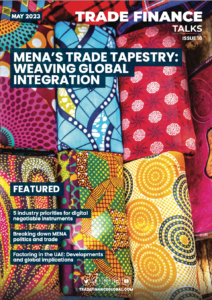Historically, the Middle East and North Africa (MENA) region has always been a cornerstone of the global trade landscape, with its strategic location, abundant resources, and diverse economies. However, the region’s complex geopolitical dynamics, regulatory challenges, and ever-changing markets have posed significant obstacles to trade finance in recent decades.
Despite these challenges, the MENA trade finance landscape is currently undergoing rapid transformation, driven by digitalisation, innovation, and the shift from a petroleum-based to a knowledge-based economy.
There isn’t a clearer example of this than the growth of the UAE. It is expected that by 2030, exports will reach $1.7 trillion, more than double the 2020 total of $800 billion. This 70% increase will significantly outpace the growth of global trade.
But the UAE is not the only example of trade growth. According to the World Bank, in 2003, MENA as a whole had a GDP of $1.15 trillion, and in 2021, it increased to $3.68 trillion.
This exponential growth highlights the opportunities within the region and the ever-expanding influence of the market.
In this era of transformation and growth, navigating the MENA trade landscape requires a deep understanding of the region’s unique challenges and opportunities.
New corridors, thanks to Brazil, the US, India and Asia, as well as opportunities between MENA and the wider African continent, compounded by the Russia-Ukraine war, are creating new trade flows.
Whether you are a trade finance provider, a corporate, or a government agency, staying ahead of the curve in MENA demands a proactive and collaborative approach that leverages the latest technologies, best practices, and partnerships. And with more international trade participation comes more economic prosperity, innovation, resilience, higher wages and productivity.
This growth is constantly accompanied by changes in strategies and regulations, as shown by the evolving factoring laws in the UAE, and the enactment of the United Nations Commission on International Trade Law’s (UNCITRAL) Model Law on Electronic Transferable Records (MLETR) in both Abu Dhabi Global Market (ADGM) and Bahrain.
As MENA countries embrace sustainability, there will be internal battles about the transformation of the economy. While ESG practices are gaining momentum by the year, a 180-degree shift from an entrenched economic and market system will undoubtedly create divisions.
The last five years of global events have proved yet again, that no one can predict the future, even the most knowledgeable experts struggle.
Black swan events will always be lurking around the corner, and growing pains in rapidly ascending regions like MENA are expected.
But what we do know, is that MENA is experiencing a moment of growth that is truly impressive, and will cement its place in global economic and geopolitical standing for the foreseeable future.
And none of this would be possible without the influence of the individuals and companies spread throughout the vast region.
Digitalisation and developing technologies may make all of the headlines, but it is the people that drive this growth.











































